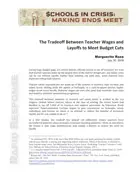Facing huge budget gaps, are school district officials forced to
lay
off
teachers?
It’s
true
that
teacher
salaries
make
up
the
largest
slice
of
the
district
budget
pie,
but
salary
costs
can
be
cut
without
layoffs.
Rather
than
handing
out
pink
slips,
some
districts
have
explored
rolling
back
salaries.
An estimated 60%–80% of the more than $500 billion per year spent operating the nation’s public schools goes directly to paying and supporting school employees. Much of the money is directed to basic teacher salary costs. The
problem
for
many
locales,
however,
is
that
wages
are
often
decided
many
years
in advance,
via
collective
bargaining
agreements.
In
contrast,
decisions
about
how
to
close budget
gaps
get
made
just
ahead
of
the
affected
school
year
as
revenue
projections
are finalized.
Sometimes
in
closing
gaps,
district
leaders
treat
salary
decisions
made
years ago
as immovable
(which
they
are
not)
and
focus
only
on
furloughs
and
layoffs.
This
Rapid
Response
brief
demonstrates
the
effect
on
wages,
layoffs,
and
class
sizes
of
a range
of
policy
options
available
to
districts
forced
to
cut
salary
expenditures.




